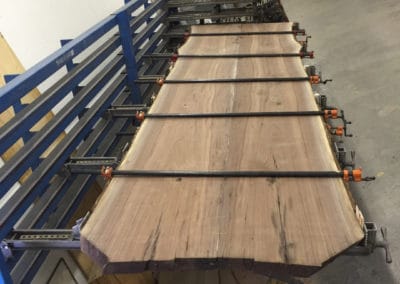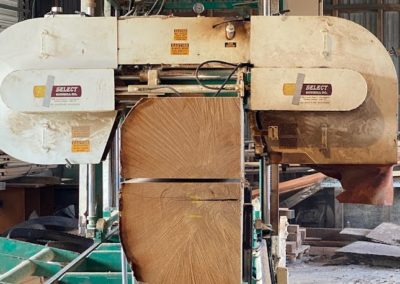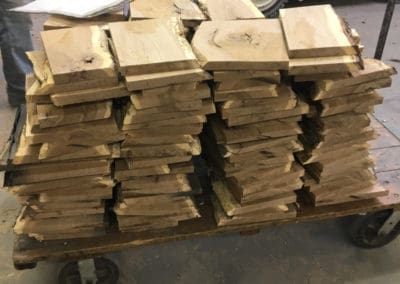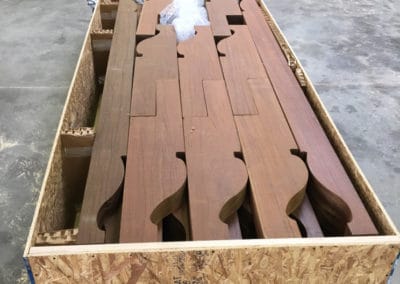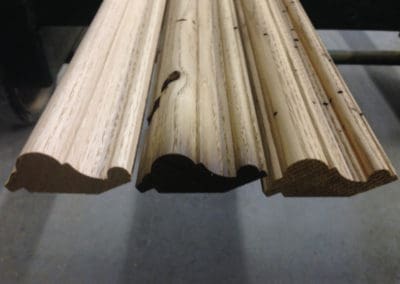Custom Millwork
What Can Bailey Do For You?
Many of our customers like to have their material surfaced by us. It saves them time in the shop, or in some cases eliminates the need for a planer entirely. We are equipped with 2 helical carbide planers that can process material up to 52” in width. The helical cutter heads do an excellent job milling figured hardwoods producing very little tear-out, providing a nice uniform finish.
Another solution to saving shop time is to have your material straight-line edged on one or both sides. This eliminates the need for a jointer and is done a lot more efficiently and safer than jointing. Our Laser guided Rip Saw allows us to work with precision in getting your material straight and ready for making parts at the table saw. We can also size your stock to specific widths, should you decide to have the material processed to that level.
Looking for thin stock for making guitars, inlays, laser material, or book-matched panels? Our horizontal band resaw, capable of sawing up to 16” in width, does a superb job of cutting smooth and flat pieces from larger stock. If you find a special piece in our showroom that you want to use for guitar making, we can saw it in sequence matched sets on our resaw to allow you to make book matched guitar backs and sides,
We have the capability of surfacing glued-up panels and live edge slabs up to 52” on our helical head planer, and wide belt sander. The combination of both machines saves many hours in the shop and provides excellent results.
Looking for custom countertops, tabletops, stair treads, bar tops, or glued panels? Our glue clamp system is capable of handling all kinds of glued-up products ranging in width up to 60” and 16’ in length, which can be adjusted up to 24’ for special projects. Custom Hardwood Flooring? With our Weinig Molder, we have the capability of producing custom hardwood flooring in any species of wood. Custom flooring is what our machine is best at, however, we can also produce moldings in the form of casing, baseboard, crown, and many others from the hardwoods we stock. If you have a need for any molding work, please contact us directly to discuss your project and pricing.

Frequently Asked Questions About Custom Millwork
Can You Match Existing Wood In My Old Home?
Yes, we can match the species and widths of flooring that you have existing in your home. We would be happy to quote your project. Please give us a call or contact us with the area you need to cover, the species of wood the flooring is made from, width(s) of each plank, and also let us know if it is knot-free, has some occasional knots, or is a character grade of flooring.
Is There A Minimum Order?
We don’t have a minimum, but we do need to cover the set up and milling costs for the machinery to produce your product. The greater the quantity, the more that cost is spread out over the run of material. The pricing quoted will reflect that cost.
Can You Match A Profile That I Already Have?
Molding profiles can be matched, but in most cases to do that, custom cutters will have to be produced to mill your order. The cost of the cutters will be included as part of the
cost to process your request.
Do you offer custom planing of material that I supply?
We can plane material that customers supply. We ask that you call ahead and arrange a time for that to be done. Our weekly schedule oftentimes doesn’t allow custom work on a will call basis, so an appointment is requested.
How much will it cost to have material surfaced that is supplied by the customer?
Please ask for current shop rates for milling services when making an appointment.
Will you plane and sand reclaimed lumber and timbers that are provided by the customer?
It is your policy that we will not machine reclaimed wood or timbers due the fact that we can’t be certain that it is free of all metal or foreign material.
Do you custom saw logs provided by the customer?
We do offer limited custom sawing to customers. Most times our schedule is full with the milling of our own materials to keep kilns filled, that we have limited time to offer that service. Please call prior to bringing out logs for milling services.
Do you offer custom kiln drying services?
We do some custom kiln drying. The challenge of offering this service is that in order to properly dry your material, stock has to be combined in the same kiln load that dries as the same rate. Mixing different thicknesses, and some species will not work in the same kiln load. This is especially true for thick materials. If you are interested in this service, please call our office to see if we can accommodate your needs.
Understanding Waste
After determining the exact board footage necessary for your project, add the waste factor to the exact measurement as a guideline to determine the amount of rough lumber needed for construction.
The following species should add an additional 20% to the exact measurement.
African Mahogany, Sapele, Bubinga, Padauk, Bloodwood, Yellowheart, Purpleheart, and Lacewood
The following species should add an additional 25% to the exact measurement.
Red Oak, White Oak, Poplar, Ash, Birch, Pine, Sassafras, Basswood, Catalpa, Sycamore, Wenge, African Cherry (Makore), Brazilian Cherry (Jatoba), Western Red Cedar, Spanish Cedar
Hard and Soft Maple
Our Maple is selected for Sap on a minimum of one face, and a lot of the stock is white on both faces. Unless the stock is listed as unselected for color, where there is a high percentage of brown heartwood, we recommend using a 25% waste factor.
Hickory
Hickory coloration varies from light sap white to many hues of brown intermixed with the light sap color. Our stock varies from kiln load to kiln load. If you are looking for a greater amount of one color over another it is best to call and inquire about the variation of the coloration of the stock in inventory at present. Depending on the coloration of your finished product we would recommend using a waste factor of 30% - 50% depending upon the color variation you are looking for in the finished product. Hickory is also very difficult to machine due to its hard stringy grain. Based upon its working properties it is also advisable to make sure that you have some extra material in case of tear out during machining.
Zebrawood
For Zebrawood we recommend a 35% waste factor.
Aromatic Cedar
Aromatic Cedar is sold on the grade of #1C and better. Within this grade, bark pockets are allowed as long as the required cuttings are within the piece of lumber to allow it to make the #1C and better grade. Tight knots are allowed and interspersed throughout the lumber in this grade. If you are looking for clear lumber, this is not a species to choose. Based on the characteristics of Aromatic Cedar we recommend using a 40% - 50% waste factor when building projects from the material. The bark pockets and presence of knots, especially when creating larger glued panels for blanket chests, will make it necessary for the user to lean more toward the 50% figure.
Black Cherry
Our Cherry lumber is sorted for color. The stock is Red heartwood on one face minimum and most is 50% Red heartwood on the reverse side. The Cherry is Pennsylvania stock coming from the northern part of Pennsylvania and occasionally into New York. We strive to maintain consistency of the color from kiln load to kiln load. We also purchase stock in that is sorted to our color specifications in specific widths and occasionally specific lengths. Based on the quality of the stock we recommend using a 35% waste factor when calculating your material needs in Cherry. If you have a project where you can use some percentage of sapwood, you can slightly reduce the waste factor.
Walnut
Our Walnut is sold two different ways, unsteamed and steamed. The steaming process darkens the light sapwood to match the darker heartwood much more closely than that of unsteamed. Walnut that is unsteamed has the lighter sapwood present on the edges of the outer edges of the lumber produced and on one side of the resulting lumber in the first few boards produced from each log. Depending on your ability to use sapwood in the unsteamed lumber we recommend using a waste factor of 40% - 50% for unsteamed. In steamed lumber figure a waste factor of 35%. For those that like a more natural look to their Walnut I recommend the unsteamed. The characteristics of each tree show up more vividly in the unsteamed than the steamed, especially when finished with a hand-rubbed finish.
The National Hardwood Lumber Grading Rules for Walnut are different than that of other species such as Cherry and Oak. An FAS board in Walnut will be similar in appearance to that of a #1C board of the other species due to the smaller cutting unit sizes. Keep that in mind when purchasing Walnut for a project where you are in need of defect-free cuttings. When we develop clear Walnut lumber we will select that out and keep it separate from the FAS grade material to aid those woodworkers in need of clear lumber.
Figured Lumber (Curly Maple, Curly Cherry, Wormy Curly Maple, Figured Makore, Quartersawn Sycamore, Flame Birch)
When working with figured materials, we recommend using a greater waste factor than that listed depending on how exact you wish to match grain and figure patterns in the lumber.

